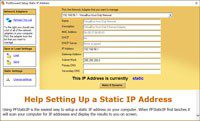

- PORT FORWARD NETWORK UTILITIES PRO 3.5 DRIVER
- PORT FORWARD NETWORK UTILITIES PRO 3.5 SOFTWARE
- PORT FORWARD NETWORK UTILITIES PRO 3.5 CODE
- PORT FORWARD NETWORK UTILITIES PRO 3.5 LICENSE
Why does exFAT need a license on ADM 3.5 but not on ADM 4.0? Wake on WAN does not support PPPoE, Link Aggregation or VLAN settings.Īlways ensure ADM is up to date to gather the latest fixes. What are the limitations of Wake on WAN (WOW)?
PORT FORWARD NETWORK UTILITIES PRO 3.5 CODE
What is the ECCN and HS code for ASUSTOR products?Īn ECCN (Export Control Classification Number) is a five alpha-numeric designation for dual-use items that are listed on the Commerce Control List (CCL) to ensure these items are not for military use.Īn HS (Harmonized System) code is used for standardized international trade.
PORT FORWARD NETWORK UTILITIES PRO 3.5 SOFTWARE
To each other.How to block Ads with Pi-hole® ? (For x86-64 platform NAS)įor more information, please refer to Pi-hole® is an ad-blocking software and powerful local DNS service who helps to audit queried domains on your network.Īnd also, Pi-hole® can operate in many systems, this article will show you how to. You can use swarm services instead of standalone containers, and takeĬontainers connected to the same user-defined bridge network effectively expose all ports Multiple containers can be started together using docker-compose and theĬompose file can define the shared variables. Multiple containers can mount a file or directory containing the shared However, thereĪre superior ways to share environment variables. Variable sharing is not possible with user-defined networks. Originally, the only way to share environment variables between two containers

Linked containers on the default bridge network share environment variables. Network requirements, you can configure each user-defined bridge separately, If different groups of applications have different User-defined bridge networks are created and configured usingĭocker network create. Itself, and requires a restart of Docker. In addition, configuring the default bridge network happens outside of Docker If your containers use the default bridge network, you can configure it, butĪll the containers use the same settings, such as MTU and iptables rules. To remove a container from the defaultīridge network, you need to stop the container and recreate it with differentĮach user-defined network creates a configurable bridge. Using a user-defined network provides a scoped network in which only containers attached to that network are able to communicate.Ĭontainers can be attached and detached from user-defined networks on the fly.ĭuring a container’s lifetime, you can connect or disconnect it from This can be a risk, as unrelated stacks/services/containers are then able to communicate. User-defined bridges provide better isolation.Īll containers without a -network specified, are attached to the default bridge network. Gets complex with more than two containers which need to communicate.Īlternatively, you can manipulate the /etc/hosts files within the containers,īut this creates problems that are difficult to debug. These links need to be created in both directions, so you can see this

To manually create links between the containers (using the legacy -linkįlag). If you run the same application stack on the default bridge network, you need Your containers web and db, the web container can connect to the db containerĪt db, no matter which Docker host the application stack is running on. Imagine an application with a web front-end and a database back-end. On a user-defined bridge network, containers can resolve User-defined bridges provide automatic DNS resolution between containers.Ĭontainers on the default bridge network can only access each other by IPĪddresses, unless you use the -link option, which isĬonsidered legacy. Differences between user-defined bridges and the default bridge User-defined bridge networks are superior to the default bridge

You can also create user-defined custom bridge When you start Docker, a default bridge network (alsoĬalled bridge) is created automatically, and newly-started containers connect
PORT FORWARD NETWORK UTILITIES PRO 3.5 DRIVER
Theĭocker bridge driver automatically installs rules in the host machine so thatĬontainers on different bridge networks cannot communicate directly with eachīridge networks apply to containers running on the same Docker daemon host.įor communication among containers running on different Docker daemon hosts, youĬan either manage routing at the OS level, or you can use an Isolation from containers which are not connected to that bridge network. In terms of Docker, a bridge network uses a software bridge which allowsĬontainers connected to the same bridge network to communicate, while providing A bridge can be a hardwareĭevice or a software device running within a host machine’s kernel. Which forwards traffic between network segments. In terms of networking, a bridge network is a Link Layer device


 0 kommentar(er)
0 kommentar(er)
